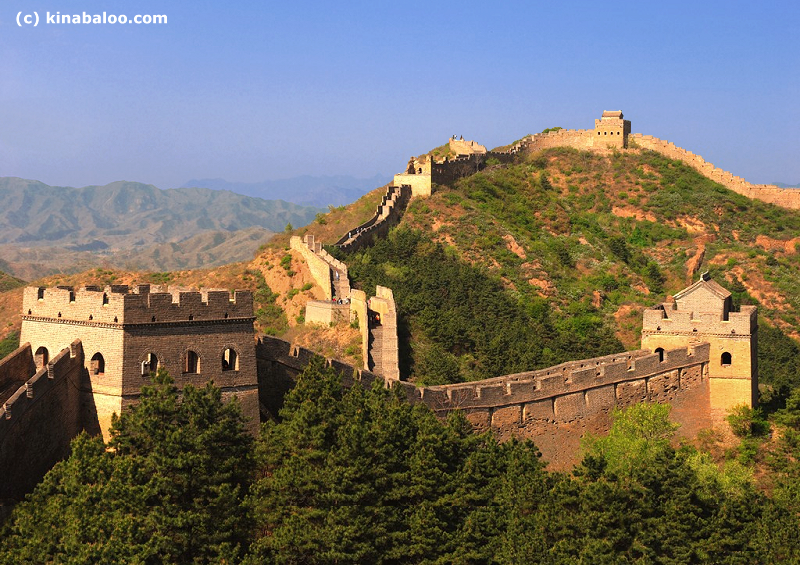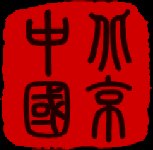Introduction to the Great Wall of China 
 The Great Wall of China is an immensely long man-made wall that was built to keep out invaders. It spans nine provinces and its total length is 6,700 km (3,948 miles). The Great Wall extends from ShanHaiGuan (the 'Old Dragon Head'), a seaport along the coast of BoHai, in the east (near BeiDaiHe resort) to JiaYuGuan Pass in GanSu Province in the west. Like a giant dragon, the Great Wall of China winds its way across grasslands, deserts and mountains. In this guide, we look at the history of the Great Wall and its design and construction.
History of the Great Wall of China  Although the Great Wall of China was originally built for protection, the wall stands as a tribute to the amazing ingenuity of the Chinese. Listed as a World Heritage Site by UNESCO in 1987, the Great Wall ('Chang Cheng' in Chinese) is a true marvel and a testament to the long history of the Chinese Civilisation. Today, people from all over the world visit to walk on the Great Wall of China, to stand on a watchtower and view the wall snaking into the distance. This treasure is now protected so that future generations can see the Great Wall with the same wonder and amazement as we do now. Some parts of the Great Wall of China have almost disappeared. Some parts have been overwhelmed by the elements. Some have been by the desert. Others eroded by local people recycling the wall's materials for constructions in their villages. Nevertheless, the Great Wall in large part still stands in silent splendor, enduring the passage of time and greeting the changes of the seasons as it has done for many hundreds of years. Early Great Walls  The history of the Great Wall is a long one - it was built over many hundreds of years. Walls were first built to keep invaders away from the farming villages on the Chinese border. These walls were built at weak points in the natural landscape or where the threat was perceived as greatest. Some of these walls eventually became of greater strategic importance when the localised defences were gradually joined to form the Great Wall of China. At those times that the Chinese territory expanded northward, earlier walls became secondary defences when a more northernly wall was built. In the early days, the Great Wall was as much a demarcation of territory as a defence as such, but as the Great Wall became stronger, it's defence role increased. Where possible, natural barriers were integrated into the path of the wall. This is particularly true for mountains - their height was used to gain both a greater view and for advantage in defense. The Great Wall of China was built by soldiers, civilians, farmers and prisoners, primarily during three dynasties: the Qin, the Han and the Ming, although the Sui Dynasty and the Ten Kingdoms period also played a part. The building styles of each dynasty added their own flavor and advanced the techniques learned from the previous. Qin Dynasty  The first dynasty of China was the short-lived Qin Dynasty (221-206BC). The first emperor, Qin ShiHuang, was a tyrannical emperor who unified China by force and set about constructing one Great Wall - by joining, where possible, existing one and filling the gaps. He even sent scholars to work on the Great Wall - anyone who was deemed unproductive. These workers faced arduous labor, and the constant danger of being attacked by bandits. Most of the early Great Walls were composed of loose stone, but when the natural stone in an area was not sufficient, the engineers turned to another method of wall building - a stoneless wall that was built using a wooden, rectangular frame that was then filled with loose soil. The soil was trampled down for many hours by a team of workers until it was solid. This process of filling and trampling would be repeated over and over until the wall reached the desired height.
Han Dynasty
 The second dynasty to add to the Great Wall was the Han Dynasty (206BC-220AD). This dynasty rose to power in 206 BC after the fall of the Qin. The most notable contribution of the Han Dynasty is that they extended the Great Wall westwards through the Gobi Desert. Despite a lack of building materials, ingenious Chinese engineers found a solution. Their answer was similar to that of the Qin, but created a stronger wall. This method involved first laying down a layer of willow reeds, possibly woven. Then a layer of gravel and a little water was applied and trampled solid. After the trampling, a new layer of reeds and gravel was added. This process would be repeated until the desired height was reached. Amazingly, some portions of this Great Wall are still standing, partly due to the dry conditions of the Gobi. The Han also improved the watchtowers of the Great Wall - making them two storied to gain a better lookout. The Great Wall we see today Ming Dynasty  The last dynasty to build a northern defensive wall was the Ming Dynasty (1368-1644). This dynasty built the biggest, longest, strongest and most ornate Great Wall ever. These are the walls that we are familiar with today. The early Great Wall was located much further north than the current Ming wall, with its eastern end at modern day North Korea. Very little of this first wall remains - although aerial photographs do reveal a low, long mound. The Great Wall that the Ming created was, more or less, completely new. The Ming Emperors, having overthrown the Mongols from the north, devoted large amounts of material and manpower to making sure that they (and the other semi-nomadic peoples to the north) could not return.  Their methods of Great Wall building fused all that was learned by the two previous dynasties. First, a center of trampled earth was created. Then, around the firm center was applied a shell of stone and bricks. The bricks that were created by the Ming are so strong that they compare well with the ones we use today. Near Beijing, the Great Wall is constructed from quarried limestone blocks and fired bricks. The strong Ming wall was built across some of the most dangerous terrains in China, including steep mountains, sometimes on 75 degree inclines! It has been said that every foot of the construction of this Great Wall cost one human life.  The Ming Dynasty Great Wall starts on the eastern end at ShanHai Pass, near QinHuangDao, in Hebei Province, next to Bohai Sea. It once spanned 9 provinces and 100 counties, but the final 500 kilometers of the Great Wall to the west have all but turned to rubble. Today, the western end of the Great Wall effectively ends at the historic site of JiaYuGuan Pass, in northwest GanSu Province, at the limit of the Gobi Desert and the oases of the Silk Road. JiaYuGuan Pass was intended to greet travelers along the Silk Road. Although the Great Wall now ends at JiaYuGuan Pass, there are many watchtowers extending beyond there along the Silk Road. In 1644, after two years of trying, the Manchus finally crossed the Great Wall by bribing an important general, Wu SanGui, to open the gates of ShanHai Pass and allow the Manchus into China. Legend has it that it took three days for the huge Manchu army to pass through the Great Wall.  So began the Qing dynasty. After the Manchu conquered China, the Great Wall was of less strategic value, mainly because the Manchu extended their political control far to the north of it, much further than any previous Chinese dynasty. The last Great Wall of the Ming Dynasty was a military fortification of great strength. However, historians are sometimes dismissive of its net value. It was astonishingly expensive to build, maintain and garrison and the resources the Ming spent on the Great Wall could have been spent on other military capabilities. The fact remains that the Great Wall was of no help in preventing the fall of the Ming Dynasty. However, only because the currently prevailing dynasty had weakened from within were invaders from the north able to advance and then conquer. Both the Mongols (Yuan Dynasty, 1271-1368) and the Manchurians (Qing Dynasty, 1644-1911) were able take power not because of a weakness in the Great Wall but because of a weakness in the government. They took advantage of disenchantment and rebellion and stepped into the void of power without an extended war. WatchTowers and Wall Design  Along the Ming Great Wall of China there are many watchtowers, spaced from less than a kilometer to several kilometers or more apart. These were partly used to transmit military messages. Fire and smoke were the most efficient means for communication - fire was used at night and smoke during the day. Straw and dung was used for this. In 1468, a series of regulations set specific meanings to these signals: a single shot and a single fire or smoke signal implied about 100 enemies, two signals warned of 500, three warned of over a 1000 and so on. In this way, a message could be transmitted over more than 500 km of the Great Wall within a few hours. During the Ming Dynasty, two-storied watchtowers were built on the Great Wall in strategic places. The ground floor was used for living, and storing food and weapons, and the top floor was used as a high lookout platform and also for defense. Canons were installed in strategic places, sometimes in watchtowers but also along the wall.  The watchtowers also provided a place to retreat to, if necessary, from attackers who had scaled the Great Wall. Inside, the watchtowers have narrow and puzzling layouts to confuse any infiltrators. The internal passageways and staircases were unique and restricted. This allowed defenders to pick off attackers one by one. Barracks and administrative centers were located at larger intervals along the Great Wall. Small armies were garrisoned along the length of the wall to provide early warning of invasion and a first line of defense. The outer parapet of the Great Wall is crenelated with merlons almost 2 m high from the base of the wall. The merlons provided protection from incoming fire while the gaps allowed fire at invaders.  
Videos of the Great Wall of China
[video v=xbTko4UVnHc]
| 


